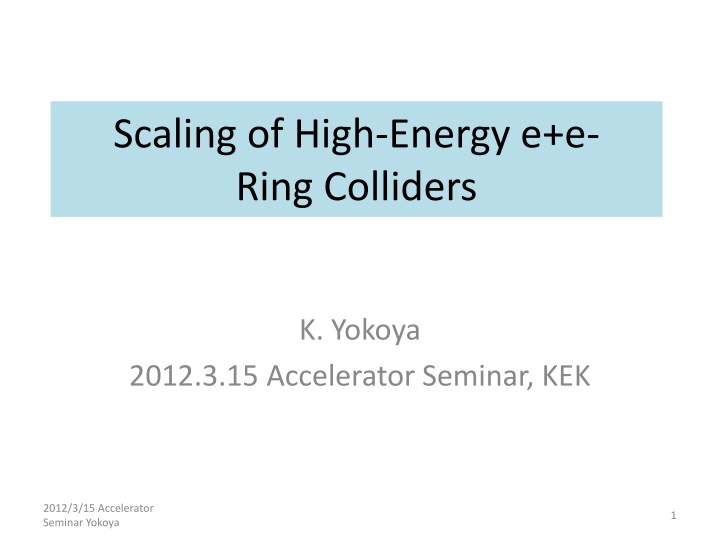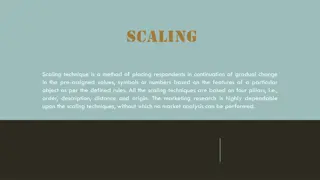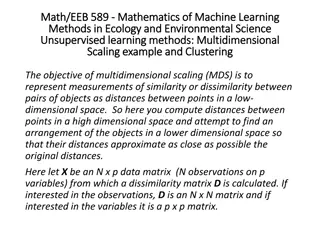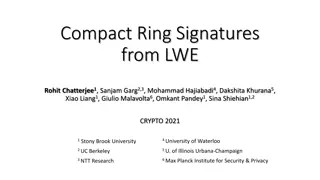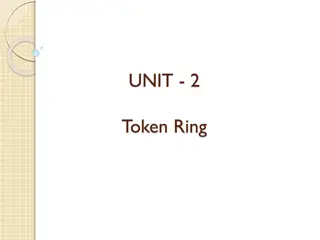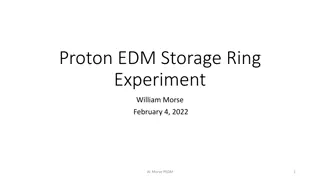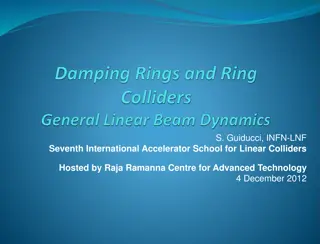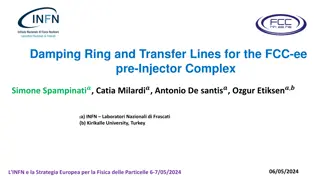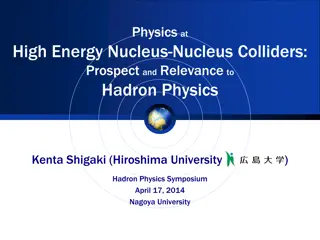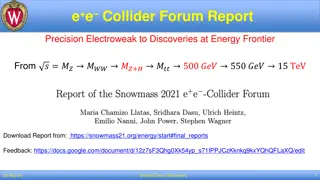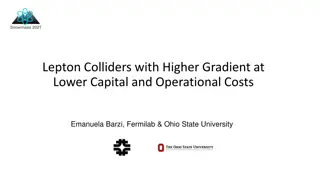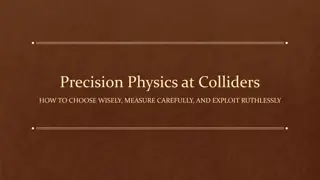Scaling of High-Energy e+e- Ring Colliders and Proposed Parameters
Scaling of high-energy e+e- ring colliders has been proposed for energy levels exceeding 200GeV by various authors. The suggested collider possibilities include different tunnel configurations and collider designs. Common features for reducing synchrotron radiation include large circumferences and lower bunch numbers compared to B factories, with bunch collision frequencies ranging from 5kHz to ~150kHz. Beamstrahlung effects and proposed parameter sets for colliders like SuperTRISTAN are also discussed.
Download Presentation

Please find below an Image/Link to download the presentation.
The content on the website is provided AS IS for your information and personal use only. It may not be sold, licensed, or shared on other websites without obtaining consent from the author.If you encounter any issues during the download, it is possible that the publisher has removed the file from their server.
You are allowed to download the files provided on this website for personal or commercial use, subject to the condition that they are used lawfully. All files are the property of their respective owners.
The content on the website is provided AS IS for your information and personal use only. It may not be sold, licensed, or shared on other websites without obtaining consent from the author.
E N D
Presentation Transcript
Scaling of High-Energy e+e- Ring Colliders K. Yokoya 2012.3.15 Accelerator Seminar, KEK 2012/3/15 Accelerator Seminar Yokoya 1
Proposed Ring Colliders Recently several authors suggested possibilities of e+e- ring colliders for Ecm>200GeV. A) T.Sen, J.Norem, Phys.Rev.ST-AB 5(2002)031001 C=233km tunnel for VLHC B) A.Blondel and F.Zimmermann, CERN-OPEN-2011-047, Jan.2012 (Version 2.9). arXiv:1112.2518 LEP3, DLEP C) K.Oide, "SuperTRISTAN: A possibility of ring collider for Higgs factory", KEK meeting on 13 Feb 2012. SuperTRISTAN D) G.Lyons, arXiv:1112.1105 [physics.acc-ph], Feb.2012. PhD thesis. Nanobeam version of A) E) D.Summers, et.al. Rapid Recycling Magnets - Tests & Simulations , Muon Accelerator Program 2012 Winter Meeting, 4-8 Mar.2012. SLAC. Small ring version of D) 2012/3/15 Accelerator Seminar Yokoya 2
Reference Parameters SuperT RISTAN C Name LEP2 LEP3 VLCC CW250 Summers reference Circumference Beam energy Bunch population Number of bunches/beam Number of IP Bunch collision frequencykHz geo.emit(x) geo.emit(y) betax betay sigx sigy sigz half.cross.angle bending radius radiation loss/turn Damping partition radiation power (2beams) MW Tune shift (x) Tune shift (y) Equilibrium energy spread % Luminosity per IP B A D E km GeV 10^10 26.7 104.5 57.5 26.7 120 133.3 60 233 200 48.5 114 233 250 48.5 46 13.82 120 48.5 200 249.2 4 4 3 2 1 1 3 1 1 1 44.91 33.69 5.00 3.2 0.017 146.68 3.09 0.031 0.00067 1000 10 55.63 0.56 6.67 0 32.07 4.42 2 100.7 0.18 0.18 0.096 0.88 59.19 65.07 nm nm mm mm micron micron mm mrad km GeV 48 20 0.9 3.6 0.25 1500 0.15 150 1.2 54.77 0.4243 0.00099 30 20 0.6 4.25 20 0.6 8.5 50 0.32 9.8 268 3.536 16.1 0.0738 0.0201 6.67 0.0244 6.67 3 0 1.4 35 7.65 18.5 0 17 34 1.9 9.7 3.096 3.408 1.1 2.62 6.99 1.5 100 0.126 0.13 0.232 1.33 32.07 10.8 2 2 2 22 74 100.7 0.027 0.23 0.120 9.7(4.8) 98 0.025 0.065 0.22 0.0125 0.017 0.155 0.196 0.0014 0.2 0.236 4.4(2.2) 10^34 5.2 Not given in the reference. Computed from other values Not given in the reference. Assumed. quoted(computed) 2012/3/15 Accelerator Seminar Yokoya 3
Common Features For reducing synchrotron radiation Large circumference small number of bunches compared with B Factories Bunch collision frequency ranges 5kHz to ~150kHz compared with 13kHz in ILC Luminosity similar to ILC Luminosity by one bunch collision comparable to ILC Beamstrahlung similar to ILC 2012/3/15 Accelerator Seminar Yokoya 4
Beamstrahlung for Proposed Parameter Sets SupTRI STAN Name LEP2 LEP3 VLCC CW250 Summers Circumference Beam energy Bunch population Number of bunches/beam geo.emit(y) betax betay sigx sigy sigz Equilibrium energy spread % Luminosity per IP check Luminosity per IP disrup(x) disrup(y) simulation assumed crossing angle Ngamma dE_BS sigE/E sigE/E*sqrt(DampTurn) Luminosity per IP km GeV 10^10 26.7 104.5 57.5 26.7 120 133.3 40 233 200 48.5 114 0.031 0.00067 1000 10 55.63 0.56 6.67 0.096 0.88 233 250 48.5 46 13.82 120 48.5 200 249.7 4 3 1 3 nm mm mm micron micron mm 0.25 1500 0.15 150 1.2 54.77 0.4243 0.0738 3 0.232 1.33 0.017 0.00099 30 20 0.6 4.25 20 0.6 8.5 50 0.32 9.8 268 3.536 16.1 0.22 0.0125 0.0201 6.67 0.121 0.0244 6.67 0.239 1.4 0.196 10^34 5.2 9.7 4.4 10^34 0.0125 0.0036 0.2692 2.050 0.0320 0.0101 4.1300 7.129 0.881 0.0151 1.4953 16.3397 4.858 0.0029 2.200 0.0015 14.0210 9.650 mrad 0 0 40 0 17 34 0.0798 8.70E-05 7.06E-04 0.0053 0.00943 1.09 0.092 0.202 0.966 1.376 4.57 8.6 9.1 29.92 3.29 0.3707 0.008 0.0323 0.217 0.97 0.6706 0.153 0.5332 2.565 4.222 0.3409 0.019 0.0467 0.164 1.886 % % % 10^34 Contribution of only oneinteraction point 2012/3/15 Accelerator Seminar Yokoya 5
Beamstrahlung The average energy loss and the number of photons per electron for the head-on collision with beam energy E= mc2, bunch charge eN, rms bunch length z, beam size x, y, are given by integration length BB Field For flat beams, x+ y~ x 2012/3/15 Accelerator Seminar Yokoya 6
Interaction Length In the case of head-on collision, the orbit length in the on-coming beam is effecttively min( z, y) In the nanobeam scheme, choose y<< z.The interaction length is ~min( y, x/ ) ( = half crossing angle) Combining these, define As crude approximation, Leff can be used instead of z in the formulas of Luminosity, tune-shift, energy loss, number of photons. Note: better to eliminate y for beamstrahlung because the beamstrahlung is insensitive to the vertical beam size. But OK because we consider here only the case of y close to either one the of others. x/ z 2012/3/15 Accelerator Seminar Yokoya 7
Relevant Formulas 2012/3/15 Accelerator Seminar Yokoya 8
Beamstrahlung Limit If you raise the beam energy under tuneshift limit with fixed beam structure, the power limit of synchrotron radiation is soon reached. If the upper limit of power is set high, beamstrahlung limit is reached soon or later. Beamstrahlung limit is very much different between Ring colliders and Linear colliders In the case of Linear colliders, the limit comes basically from physics requirements. (Very high beamstrahlung, e.g., >20%, may also be a problem of accelerator: to safely lead the beam to the dump.) In the case of Ring colliders, the beam after beamstrahlung must circulate safely over the ring. The energy loss by one collision BS (energy spread is comparable or larger discuss later) will accumulate over the radiation damping time. The equilibrium energy spread will be about Sqrt(number of turns in damping time) x BS which is order of percent even if BS=0.1%. Very large momentum aperture is needed. 2012/3/15 Accelerator Seminar Yokoya 9
Beamstrahlung Limit Luminosity Once the beamstrahlung limit is reached, the luminosity above this energy goes down as 1/E4 Or 1/E4.5if geometric emittance is fixed) If the bunch charge is reduced to 1/n, BSreduces by 1/n2 but the luminosity is also reduced by 1/n2 . To restore the luminosity the number of bunches must be increased by n2 times, hence the required power increases by n2x 1/n = n . 2012/3/15 Accelerator Seminar Yokoya 10
Increase of dynamic aperture by a significant factor is unrealistic For given luminosity and power consumption the only cures are Huge ring (like 233km of VLCC) Extremely small vertical emittance (like <1pm of CW250 and Summers) 2012/3/15 Accelerator Seminar Yokoya 11
Energy Spread What really matters in ring colliders is not the average energy loss BSbut the energy spread BS The former is anyway compensated by the RF system The energy spread due to the beamstrahlung is discussed in K. Yokoya, NIM A251 (1986) 1-16 for round Gaussian beam and elliptic cylinder beam. There are two mechanisms of energy spread Orbit in the on-coming bunch is different from particle to particle Stochastic spread even along the same orbit It was shown the latter is dominant unless n (number of photons) is very large, e.g., for round Gaussian beams almost no correlation between successive collisions If the typical photon energy is , then the average energy loss is BS n and the spread due to the stochastic process is BS (n ) Hence , BS BS/ (n ) 2012/3/15 Accelerator Seminar Yokoya 12
Energy Spread (continued) According to the simulations for the above parameter sets (and others), BS 2.4 BS/ (n ) For not totally unrealistic parameter sets, n is about 1 or less. Hence BSis significantly larger than BS The equilibrium energy spread is the square sum of synchrotron radiation and beamstrahlung. The latter is approximately 2012/3/15 Accelerator Seminar Yokoya 13
Luminosity Scaling with Given 2012/3/15 Accelerator Seminar Yokoya 14
Conclusions The luminosity scaling of ring colliders at beamstahlung limit is established. The ring colliders (in particular for Ecm=400 and 500GeV) are scientifically impossible because of the energy spread due to the beamstrahlung, under the constraints that the luminosity and power consumption are comparable to those of ILC. The only way to solve is Huge ring Extremely small vertical emittance The machine for Ecm=240GeV is at the border of feasibility. It is not a trivial machine. It requires serious studies of lattice design with very large momentum aperture or very small vertical emittance. 2012/3/15 Accelerator Seminar Yokoya 15
